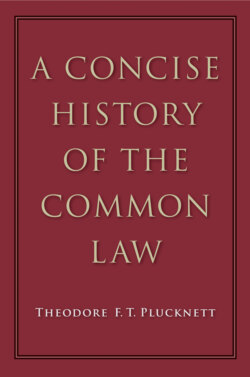Читать книгу A Concise History of the Common Law - Theodore F. T. Plucknett - Страница 94
На сайте Литреса книга снята с продажи.
FRANKPLEDGE
ОглавлениеTo all this must be added the system of frankpledge which later became typical of a good many manors. Its history can be clearly traced back to the Anglo-Saxon period where we find the institution of friborh. “Borh” is the root which we have in the modern word “borrow”, and seems to have the significance of security or surety. Its general feature is the provision for every person of some other persons who shall be borh or security that whatever moneys have to be paid will be forthcoming, and that if necessary the party can be produced in court. A master was always borh for his servants; members of a family might be borh for one another; or gilds might be formed whose members undertook to be borh for their brethren. To all this must be added the obscure institution of the tithing whose root significance is a group of ten men, naturally suggesting some intimate relationship with the hundred. Eventually the tithing became a territorial division with a tendency to coincide with the vill or township, and the tithing-man, its head, became the village constable. Cnut required his subjects to be in tithing and in borh as well,1 and regular means were established for ascertaining that every person (who was not of some substance) was duly enrolled in tithing and in borh. This machinery was operated by the sheriff through the hundred court. At the time of the Conquest it seems that lords were able to shift their responsibility of being borh for their tenants on to the tenants themselves;2 this change was not very difficult, especially where the lord either owned or controlled the hundred court which had the duty of working the tithing system. The result was known to the Norman lawyers as frankpledge, and lords who owned hundred courts might also have the additional right (which normally belonged to the sheriff), of verifying the proper enrolment of every tenant in a frankpledge. This was called “view of frankpledge”.3
Under seignorial influences, then, we have seen the vill gradually falling under the control of the lord of the manor, save only for a few important police duties which the Crown imposed upon the vill direct, and even here it may be that the lord found ways of taking a profit. The institution next above the vill, the hundred, likewise fell into private hands in numerous cases, and in many instances the lord of a hundred could exclude the sheriff from his tourn in that particular hundred and hold it himself as a “court leet”. In later times, legal theory attributed to many manors three different courts—court leet, court baron, court customary. Even when the theory was current law, there were practical difficulties in separating the three jurisdictions1 and during the middle ages there was little attempt to draw fine distinctions. The leet was the most distinctive, with its view of frankpledge: for the rest, a general and wide jurisdiction was exercised without regard for speculative difficulties.
